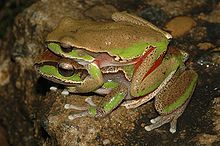Blue Mountains tree frog
This article includes a list of general references, but it lacks sufficient corresponding inline citations. (July 2021) |
| Blue Mountains tree frog | |
|---|---|

| |
| Scientific classification | |
| Domain: | Eukaryota |
| Kingdom: | Animalia |
| Phylum: | Chordata |
| Class: | Amphibia |
| Order: | Anura |
| Family: | Hylidae |
| Genus: | Ranoidea |
| Species: | R. citropa
|
| Binomial name | |
| Ranoidea citropa (Péron, 1807)
| |

| |
| Distribution of the Blue Mountains tree frog | |
| Synonyms[1] | |
|
List
| |
The Blue Mountains tree frog (Ranoidea citropa) also called the variegated river tree frog is a species of
Description

This is a moderate-sized frog, up to about 60 mm (2.4 in) in length. Its dorsal surface is brown with a few darker flecks. There is a dark stripe that runs from the nostril, above the
Ecology and behaviour

This species is associated with flowing rocky streams in woodland and wet or dry sclerophyll forest. This species has a two-part call, the first is a strong warrrrrk followed by several shorter notes, that sound like a golf ball going in a hole. Males call from streamside vegetation and rocks in the stream from spring to summer, normally after heavy rain.
This species is often found in highland areas, especially the Blue Mountains, hence its name.
The Blue Mountains tree frog is a host of Chlamydophila pneumoniae and Mesocoelium.[4] It is also preyed upon by the Australian copperhead.[4]
As a pet
It can be kept as a pet[5] in Australia, in captivity with the appropriate permit.
Diet
Tree frogs generally eat a variety of insects; in captivity, they eat gut-loaded crickets, their own tadpoles, guppies, spiders, and worms.
Sources
- Anstis, M. 2002. Tadpoles of South-eastern Australia. Reed New Holland: Sydney.
- Robinson, M. 2002. A Field Guide to Frogs of Australia. Australian Museum/Reed New Holland: Sydney.
- Frogs Australia Network-frog call available here.
- Frog and tadpole Study Group
- Frogs of Australia
- Department of Environment, Climate Change and Water, New South Wales: Amphibian Keeper's Licence: Species Lists
References
- ^ doi:10.2305/IUCN.UK.2004.RLTS.T41084A10385701.en. Retrieved 20 November 2021.)
{{cite journal}}: CS1 maint: multiple names: authors list (link - . Retrieved 8 July 2020.
- ^ Australia, Atlas of Living. "Species: Litoria citropa (Blue Mountains Tree Frog)". bie.ala.org.au. Retrieved 2021-07-08.
- ^ a b "Blue Mountains Tree Frog Interactions". GLOBI. Archived from the original on 2021-07-09. Retrieved 2021-07-08.
- ISBN 0-9758200-0-1

